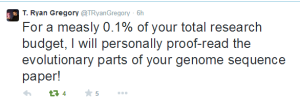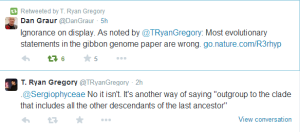
T. Ryan Gregory Starts 'Evolution Consulting Service' after Reading Gibbon Paper in Nature
T. Ryan Gregory, who had been fighting ENCODE’s junk science since 2007, is fed up with another high-profile paper published in Nature. He wrote in Twitter -


The paper in question has over seventy authors, which tends to scare us these days. More authors mean higher chance of ‘faddish stuff’ or ‘fashionable ideas’ getting promoted to the abstract, and higher risk of being humiliated by Dan Graur sooner or later.
Gibbon genome and the fast karyotype evolution of small apes
Gibbons are small arboreal apes that display an accelerated rate of evolutionary chromosomal rearrangement and occupy a key node in the primate phylogeny between Old World monkeys and great apes. Here we present the assembly and analysis of a northern white-cheeked gibbon (Nomascus leucogenys) genome. We describe the propensity for a gibbon-specific retrotransposon (LAVA) to insert into chromosome segregation genes and alter transcription by providing a premature termination site, suggesting a possible molecular mechanism for the genome plasticity of the gibbon lineage. We further show that the gibbon genera (Nomascus, Hylobates, Hoolock and Symphalangus) experienced a near-instantaneous radiation ~5 million years ago, coincident with major geographical changes in southeast Asia that caused cycles of habitat compression and expansion. Finally, we identify signatures of positive selection in genes important for forelimb development (TBX5) and connective tissues (COL1A1) that may have been involved in the adaptation of gibbons to their arboreal habitat.
We asked Ryan by email, what he saw wrong in the paper and he was kind enough to explain. Ken Weiss and co-authors often touch on similar flaws in evolutionary thinking in their interesting blog.
It’s just very basic “tree thinking”, or correctly interpreting a phylogeny. In the case of the gibbon paper, they start off with the following statement:
“In the primate phylogeny, gibbons diverged between Old World monkeys and great apes, providing a unique perspective from which to study the origins of hominoid characteristics.”
This is nonsensical. If you look at a phylogeny of primates, the Old World monkeys are the outgroup to the clade that includes gibbons and great apes. This means: a) any member of that clade is equally closely related to Old World monkeys – gibbons are not closer than humans are to Old World monkeys, b) both the great apes and gibbons are descended from a common ancestor that is not shared by Old World monkeys – it is therefore equally (in)accurate to say that great apes diverged between Old world monkeys and gibbons. Also, these are all modern species. The fact that gibbons are the outgroup to great apes absolutely does not imply that they are similar to the ancestor of the entire clade. Early branching does not equal primitive.
If you are not willing to pay for the measly sum Ryan is charging, he offers a free DIY solution - to read his 2008 paper.
Understanding Evolutionary Trees
Charles Darwin sketched his first evolutionary tree in 1837, and trees have remained a central metaphor in evolutionary biology up to the present. Today, phylogeneticsthe science of constructing and evaluating hypotheses about historical patterns of descent in the form of evolutionary treeshas become pervasive within and increasingly outside evolutionary biology. Fostering skills in tree thinking is therefore a critical component of biological education. Conversely, misconceptions about evolutionary trees can be very detrimental to ones understanding of the patterns and processes that have occurred in the history of life. This paper provides a basic introduction to evolutionary trees, including some guidelines for how and how not to read them. Ten of the most common misconceptions about evolutionary trees and their implications for understanding evolution are addressed.